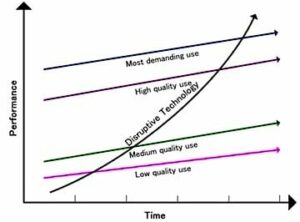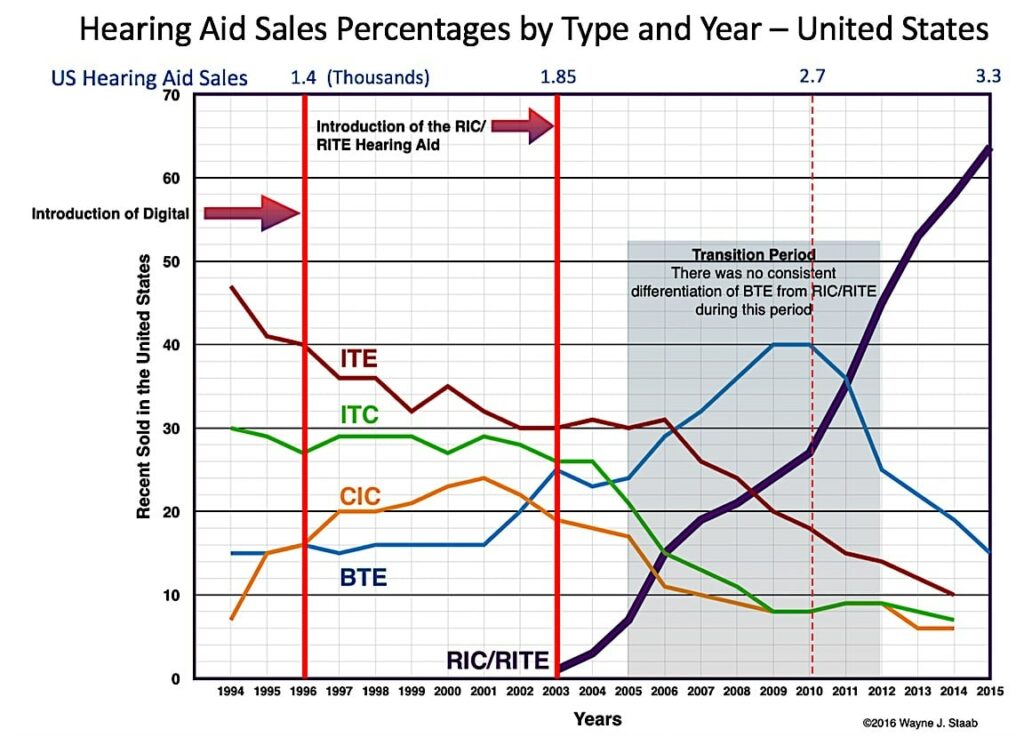The RIC (Receiver-in-Canal) Hearing Aid
In 2001, two patented hearing aid designs were filed under the “Hear-Wear” name by owners of SeboTek Hearing Systems. The result is that these, and subsequent patents by them, changed the hearing aid industry worldwide in ways never imagined. The hearing aid disruption was based on the SeboTek PAC™ (Post-Auricular-Canal) hearing aid which was presented at the AAA (American Academy of Audiology) meeting in 2003, and the hearing aid industry was forever changed – changed with an impact that rivaled, and may even have exceeded that of the integrated circuit and digital technology in hearing aids. This product became know as the RIC (Receiver-in-Canal) or RITE (Receiver-in-Ear) hearing aid. For the remainder of this post, this invention will be identified primarily under the name of Hear-Wear1,2,3,4.
More than just an invention of a new hearing aid style, this invention introduced an entirely new fitting approach resulting in improved hearing aid acoustics, comfort, cosmetic appeal, same-session fitting, speed of delivery and service, and patient satisfaction.
While the integrated circuit and digital technology changed the way hearing aids processed information, the move to both integrated circuits (ICs) and digital signal processing was expected, a natural consequence related to existing electronics. Both essentially replaced one type of signal processing with another type. They improved an existing market.
In the case of the RIC, there was no expectation that such a style should even be logically considered by those experienced in the field of hearing aids. It fact, it was a direction counter to what engineers had even been considering the prior seven years. For example, the style associated with it (BTE hearing aids) had been on a decline for years in favor of custom-molded hearing aids that fit more discretely in the ear and ear canal, were less noticeable than BTE aids, and provided a product the consumer sought.
What the Hear-Wear invention did was to spark a monumental reversal in hearing aid design, sales, and use – from custom-molded in-ear/canal variations, to essentially invisible BTE (behind-the-ear) configurations. In marketing, a product having such an impact is heralded as a disruptive technology. This article describes the activity associated with this significant industry disruption.
What is Disruptive Technology?

Figure 1. Time versus performance functions of disruptive technology compared with traditional product performances (Photo credit: Wikimedia Commons).
Disruptive technology is that which creates a new market and value network, and eventually disrupts an existing market and value network. While a disruptive innovation often takes a few years or decades to displace an earlier technology (Figure 1), the SeboTek PAC™(designed on Hear-Wear patents) concept had an immediate transitional impact.
The Hear-Wear invention ushered in a movement and approach to hearing aids counter to the direction the industry had been moving, which was to smaller custom-molded hearing aids that fit more cosmetically in the ear canal. The invention sought first to design a product for consumers and dispensers that integrated cosmetics, function, fitting ease, and service in a single instrument so that consumer management and product acceptance and performance would be optimized. These are all features the hearing aid industry has been interested since its inception.
Once the combined benefits of the Hear-Wear patent were recognized, other manufacturers followed with similar products (GN ReSound later in 2003, and Vivatone in 2004), which is typical in the hearing aid industry. Essentially all other manufacturers then followed, choosing not to use the PAC™ trademark, and to differentiate these products from traditional hearing aids, the design became known simply as a RIC (receiver-in-canal) or RITE (receiver-in-the-ear) hearing aid.
RIC – A Disruptive Innovation?
In some ways, the Hear-Wear PAC (RIC/RITE) is better described as a disruptive innovation rather than disruptive technology. This distinction is made because market disruption has been found to be a function usually not of technology itself, but rather of its changing application. Sustaining innovations (that which the hearing aid industry had been engaged in prior to the Hear-Wear patent, and that continues today), are developments to evolve existing hearing aids with better value, which allowed companies to compete against each other’s sustaining improvements.
Sustaining innovations are typically innovations in technology, whereas disruptive innovations change entire markets, which Hear-Wear’s innovation accomplished.
What was most remarkable is that while the Hear-Wear PAC/RIC was able to benefit from improved technology, it disrupted the market without the need for technology and miniaturization – it used imagination and existing components – a feat in itself.
RIC Disruptive Technology Effect on Hearing Aid Sales
By definition, a disruptive innovation should make a mark on existing sales. Figure 2 shows the dramatic changes in the hearing aid “type” of products sold by hearing aid manufacturers over the years, with special attention directed at sales after the PAC/RIC was introduced in 2003, and with percentage sales through 2015.

Figure 2. United States hearing aid industry sales percentage by type and year. HIA (Hearing Industry Association) data, years 1994 through 2015. It was not until 2009 that HIA started tracking “external receiver” BTE aids (i.e., RIC/RITE). Therefore, the estimates from 2003 until 2009 are estimates only5. Total unit sales are shown at the top for selected years.
Behind-the-ear (BTE) hearing aids as a percentage of sales were essentially flat at approximately 15% from 1994 through 2001. Sales growth from the time of the Hear-Wear invention introduction on BTE units in 2003 showed a dramatic and steady climb supporting its disruptive activity, resulting in 64% of all hearing aids sold in the US in 2015. Now that the hearing aid industry is separating traditional BTE and RIC/RITE hearing aids (since around 2009), the percentage of BTE hearing aids has dropped back to its pre-2001 percentage of about 15%.
Completely-in-the-canal (CIC) hearing aid sales percentages had been on a steady incline up to the year 2001, being fitted primarily on cosmetic features, but then began a decline to 8% in 2003, with the greatest percentage loss among all hearing aid types, coinciding with the introduction of the Hear-Wear patent product that year.
In-the-canal (ITC) sales had been steady at around 28%, had now dropped to about 8%, similar to CIC instruments in 2014.
In-the-ear (ITE) sales percentages had been on a steady decline up to the year 2003, having lost sales to the CIC and ITC instruments. Following a four-year period in which ITE sales percentages held steady at about 31%, they have dropped to about 10% in 2014.
These results demonstrate that the Hear-Wear invention that produced cosmetic, acoustic, and fitting advantages led to a disruptive behavior dramatically affecting all hearing aid styles.
A following post will explain the background of hearing aid development and how the Hear-Wear patent ends up providing cosmetic, function, and acoustics advantages, all critical to a disruptive technology.
References
- United States Patent No.: US 7,139,404. Jim Feeley, Bixby, OK (US); Mike Feeley, Tulsa, OK (US). November 21, 2006. BTE/CIC auditory device and modular connector system therefor, Filed, August 10, 2001.
- United States Patent No.: US 7,016,512. Jim Feeley, Bixby, OK (US); Mike Feeley, Tulsa, OK (US). Mar. 21,2006. BTE/CIC auditory device and modular connector system therefor. Filed Aug. 10, 2001.
- United States Patent, Patent No.: US 7,110,562 B1. Jim Feeley, Bixby, OK (US); Mike Feeley, Tulsa, OK (US). Sep. 19, 2006. BTE/CIC auditory device and modular connector system therefor. Filed: Sep. 10, 2002.
- United States Patent, Patent No.: 8,976,991 B2. Jim Feeley, Bixby, OK (US); Mike Feeley, Tulsa, OK (US). March 10, 2015. BTE/CIC auditory device and modular connector system therefor. Filed: April 30, 2010.
- Strom, K. The RIC as a disruptive technology, The Hearing Review, 2014;21(6):6.








Wayne,
Back in 1972 when Jim Delk was still at Audiotone (when there still was an Audiotone) and we at Walter Reed were purchasing Audiotone hearing aids with an R2 (or P2) response and then sending them back to Phoenix to exchange them for aids with responses of R3, 4, or 5. Jerry Schuchman and I worked on getting a prototype aid made that essentially had a “6” response and moved the receiver down the ear hook and into the canal entrance using an open earmold (that was done at our end). We had two successful fits, but couldn’t dispense the the hearing aid, of course, and we couldn’t get anyone at Audiotone interested in taking it further. Since the VA would never buy and since we had already survived an Inspector General’s investigation over WRAMC-AASPC’s “bias” over dispensing Audiotone hearing aids, it was dropped.
Later, when I was at ASU, I tried to get the folks at Shalako interested, but that proposal fell on “deaf” ears since there was no immediate upside and, if you remember, the entire issue of hearing aids, dispensing, etc was in flux.
I am very happy to see the success of this disruptive technology and my wife is a direct beneficiary of it. But, I thought I’d feed you some “unauthorized” background
It was good to get your story. It sounds as if you were definitely working in this direction. My question would be how, at the time, you might have been able to hold the feedback using such a high-pitched response?